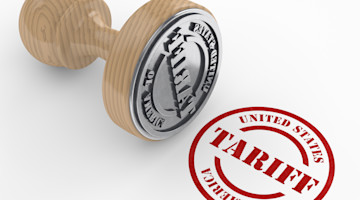This is the third article in a series on sustainability and follows “.” Watch for additional articles in the series on amtonline.org and IMTS.com.
Perhaps the greatest opportunity to improve environmental sustainability in manufacturing is through the materials we use.
There are several areas that impact a material’s sustainability, such as how it’s been sourced and processed, its longevity, waste produced, how easy it is to recycle, and if it can be reclaimed or reused. In this article, we will address material sourcing and processing. In the next articles, we will discuss material longevity, waste, recycling, and reclaiming.
Today, there are more material options than ever before in metals, polymers, rubber, and composites. When considering the environmental impact of a material, the first step is to identify how it has been sourced and refined.
Metal sourcing
The mining of metal ores can be extremely disruptive to the environment, causing erosion, deforestation, loss of biodiversity, and chemical pollution that can get into the soil and water. However, many mining companies are required to take mitigation measures as indicated in their Environmental Impact Assessments to avoid, reduce, control or compensate for negative impacts.
In 2022, the top five contributors to the total value of metal mine production in the United States were copper (33%), gold (28%), iron ore (15%), zinc (9%), and molybdenum (5%), according to the .
Lithium continues to for batteries, and copper demands are climbing for use in electric vehicles and chargers. It’s ironic that in the drive to reduce carbon emissions by moving away from petroleum powered vehicles, mining the necessary metals may have even greater environmental implications.
To address environmental concerns, many mining companies have their own , such as capturing carbon and using microorganisms to naturally degrade cyanide byproducts. Researchers are trying to find ways to either replace an ore or make the mining process less harmful. For example, is developing a geothermal alternative to open pit and underground mining to create a zero-carbon lithium. To replace lithium in rechargeable batteries, the is studying the development of calcium-based batteries.
“Calcium is around 2,000 times more abundant in Earth's crust and offers comparable metrics to lithium, so it could be a potential alternative for long term energy storage sustainability,” says ,
PhD student in mechanical engineering at the Gallant Lab.
Metal refining
Ore refining has negative environmental implications as well. Metal byproducts released into the air and water are impossible to remove. Plus, the refining process takes large amounts of energy, which produces carbon dioxide. The says carbon dioxide (CO2) is the primary greenhouse gas emitted through human activities, and industry is responsible for 15% of CO2 emissions in the U.S. Although carbon can never be completely removed from our atmosphere (it is necessary for life on Earth), it’s in everyone’s best interest to monitor and improve upon carbon emission levels.
Metal refineries are researching ways to reduce their carbon footprint by using carbon capture technology and renewable energy sources such as wind, solar, and geothermal. Learn more about the possibilities for low-carbon iron and steel production .
Polymers
Some common types of polymers in manufacturing parts today are nylon, polyethylene (PE), polypropylene (PP), polystyrene (PS), polyvinyl chloride (PVC), and polyethylene terephthalate (PET). Polymer parts (commonly referred to as plastic parts) are often produced via the injection molding and thermoset molding processes.
Synthetic polymers are derived from crude oil and natural gas, which has environmental implications such as pollution and high energy use in its drilling, mining, and processing. Its low rate of biodegradability and pervasive use has made polymers an obvious target for environmental concerns. We’ve all seen of the frighteningly large debris patches floating in oceans and waterways. Reusing and recycling polymers are the best way to reduce this problem, which we will discuss in a future article.
Polymers are a common material choice because they’re relatively inexpensive and easy to produce. A solution may be bio-based polymers made from sugarcane, sugar beets, wheat, or potatoes, for example. They use the same amount of energy in production as a synthetic polymer, but have better biodegradability rates.
Some polymers can be made from recycled material. For example, a major motorcycle company wanted sustainably sourced parts for its new line of electric bikes. , an injection molder, partnered with its resin distributor to find a solution: nylon made from abandoned fishing nets.
Rubber
Natural rubber is made from trees, while synthetic rubber is made from chemicals. Synthetic rubber is a common choice for manufacturing because it offers better resistance to abrasion than natural rubber, as well as superior resistance to chemicals, fluids, and heat. Rubber processing uses a lot of energy and water, as well as toxic chemicals that can contribute to pollution.
However, recycling rubber is less energy intensive than manufacturing new synthetic rubber, it does not require harvesting trees, and it does not require chemicals to produce.
Composites
New composite materials are constantly hitting the market, each developed to meet desired performance characteristics. Common composites used in manufacturing are resin polymers reinforced with carbon fibers, fiberglass, or other materials.
We will go into more detail about composites in the next article in our sustainability series that discusses choosing materials with longevity in mind.
Surface Protections
Coatings are another contributor to the environmental impact of a material. The metals and plastics used in coatings introduce another potential source of pollution. Hexavalent chromium (chrome VI) is a good example. Due to its carcinogenic properties, and will soon be banned in the U.S. as well. Chrome is a common coating, so many manufacturers are struggling to find alternatives. It may seem logical to look for a simple alternative such as a different kind of chrome, but there really is no exact replacement that will work in all applications. , co-founder/CEO of , has been finding creative ways to help customers deal with the chromium ban.
“In manufacturing, it’s not as simple as just replacing chrome with a new coating,” Skiba says. “How well will that coating perform? Does it change geometry? Does it change the chemical properties or performance characteristics of the material? Sometimes you can’t just slap a new coating on an existing part. There may need to be some thought into changing that part design or the material it’s made of to meet all its requirements.”
As an alternative to chrome coatings, Intalus offers an material enhancement that is 10-times harder than titanium alone and more wear resistant, making it ideal for aerospace applications. The titanium substrate becomes fully integrated with the ceramic, so it’s not just a coating.
While titanium ore is not harmful and it has many sustainability benefits such as longevity and recyclability (which we will discuss in future articles), titanium mining destroys habitat and uses toxic chlorine to extract, while titanium refining uses large amounts of energy.
Ask the supplier
There are many tradeoffs when considering the environmental impact of a material. It may have overall beneficial properties to reduce waste or improve recyclability, but its sourcing and processing may contribute negatively to its carbon footprint. A material supplier is the best resource to help weigh the pros and cons.
The key to identifying an environmentally sustainable material is to get material suppliers involved early in the design process. They can identify low-carbon or zero-carbon options that meet performance and budget needs, giving peace of mind that a company has done its due diligence and found a more responsible way to do business.
If you’re interested in improving the sustainability of your material sourcing and refining, there are resources and best practices available from the Department of Energy’s and the .
Discover more solutions in the at , Sept. 9-14, at Mccormick Place in Chicago, Ill. Register .









